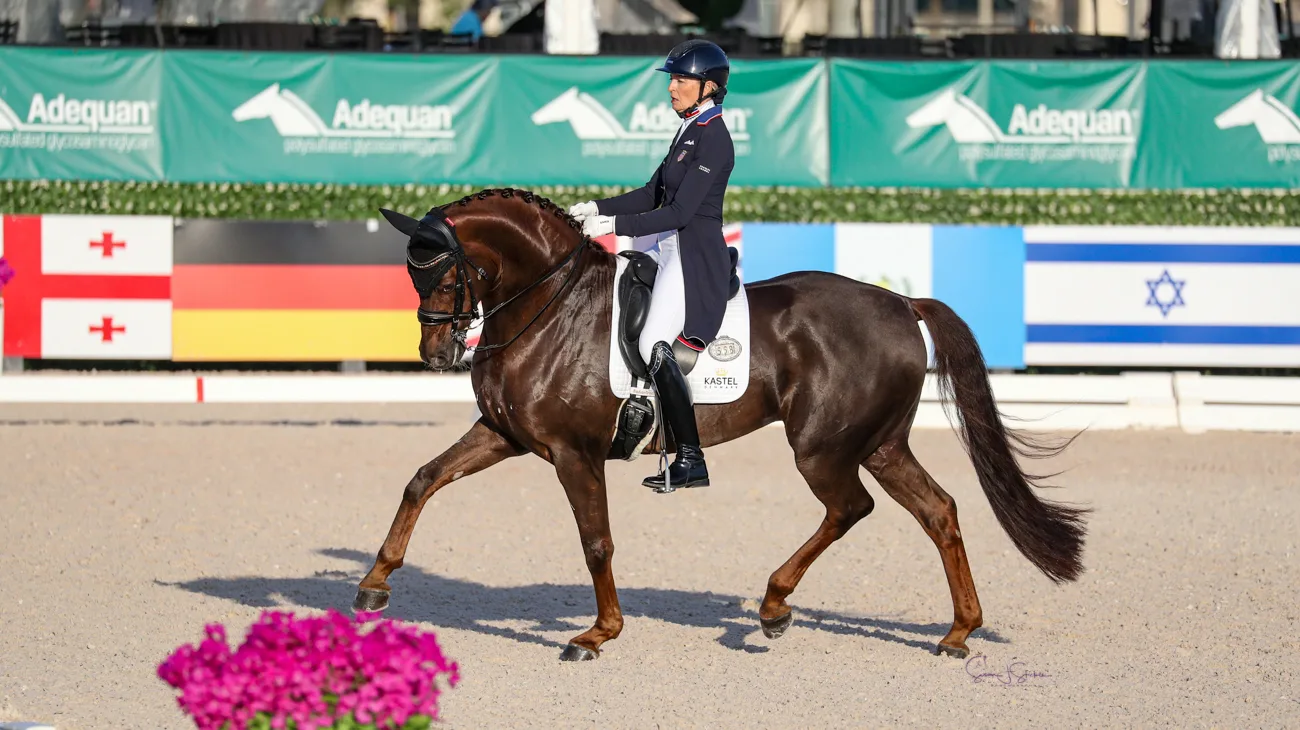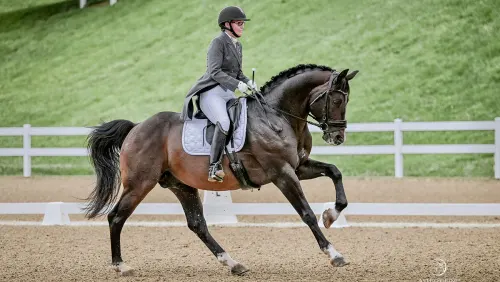For Charlotte Jorst and Atterupgaards Botticelli, the journey to international competitive success has been filled with roadblocks. One of the final obstacles, the FEI’s spur requirement, was lifted earlier this year, and the pair have since made the most of the opportunity.
Jorst and “Bo” (Benetton Dream FRH—Atterupgaards Dicte, Caprimond) swept the CDI1* classes during the final week of the Adequan Global Dressage Festival (Florida), ending the competition on a high note by earning a personal-best 75.77% in the Intermediaire I freestyle on Sunday.
Watch highlights of their test here:
As of January, the FEI no longer requires spurs in international competition. Previously, riders who wanted to ride without spurs were required to wear “dummy spurs”—completely smooth spurs without any shank—that are largely decorative. The decision to allow entirely bare heels was a welcome change for Jorst. Although she spent the circuit showing Bo without spurs, she felt AGDF Week 12 was when he finally started to trust they were gone.
“I didn’t use [spurs] in my last FEI competition either with Botticelli, but there was still the anticipation of me using the spurs back then,” she said. “This was the first time where he truly just relaxed because I had ridden him at home with no spurs for so long that he truly didn’t think that they were coming on at all. Having no spurs was a big piece of this puzzle for us. I think that if I even had to have anything on my heels at all, he would have been too hot for me.”
ADVERTISEMENT

Jorst, an adult amateur who with her now-retired Kastel’s Nintendo was shortlisted for the 2021 Tokyo Olympics and a member of the U.S. team at the 2022 CHIO Aachen CDIO (Germany), bought Bo six years ago. The now 12-year-old Danish Warmblood is tense, hot and spooky, challenging Jorst to figure out how to settle him with much time and effort.
“It was a labor of love and patience,” she said.
To illustrate Bo’s personality, she recalled a story of offering him a treat after a lesson with trainer Charlotte Bredahl.
“I gave him a sugar cube after a lesson because he had been pretty good,” she said. “He took the sugar cube in his mouth, and then he dropped it, so it fell to the ground. And he just looked at the sugar cube, and he looked at it and looked at it, until all of a sudden he just turned and bolted 200 yards the other way. And this was, like, last year; this wasn’t when he was 6.”
Ditching the spurs has helped Bo, and with the relaxation of the FEI rule, Jorst has now ridden most of her horses without them, she said. Though Bo has been the most successful, Jorst has appreciated the chance to rethink her training approach to all her horses.
“I just feel that it’s so important and exciting that we, as riders, can make the right choices for the horses,” she said. “They’re no longer choices that are made for us already. Going without spurs makes you think. It’s really important as a rider to always think about what’s best for the individual horse at that moment, whether it’s riding in a single bridle with no spurs, with smaller spurs, or whatever. You always want to have less aids.”
Going forward, Jorst hopes that someday double bridles, like spurs, will be optional at the upper levels of international competition. Under current FEI rules double bridles are compulsory at the three-star level and above (excluding ponies, children, juniors and young riders). The topic has been hotly debated in recent years, with organizations like the International Dressage Riders Club and International Dressage Trainers Club strongly supporting their continued use at the top of the sport (some of the arguments in favor are reflected in this blog post by Catherine Haddad Staller), while horse welfare and ethics groups have increasingly called on the FEI to make their use optional. The FEI General Assembly declined to discuss a possible rule change at its most recent meeting in November 2023.
“I usually use the double at home, but if they hang a little bit on the double, I like to use the snaffle the next day,” Jorst said. “Wouldn’t it be wonderful to have the option to ride in a snaffle at a competition as well? I think it’s a must.”
That choice is what’s most important, in Jorst’s eyes. She still occasionally wears spurs aboard her current Grand Prix partner, the 11-year-old Danish Warmblood Zhaplin Langholt (Zonik—Sonia Langholt, Stedinger). He made a successful Big Tour debut in January, winning both the Grand Prix (69.17%) and the Grand Prix Special (64.68%) at the Gold Coast Dressage CDI3* (Florida).
Going without spurs has not only helped her horses, it’s helped her become a more subtle rider, Jorst said.
ADVERTISEMENT
“It’s helped me with my seat tremendously, to help me ride off my seat,” she said. “I’m much more conscious of my seat than I was because, with no spurs, you have very little aids on the legs. That was scary in the beginning, because I was like, ‘Is he going to feel this? I’m barely moving up here!’ But they do feel it, they really do.”
Jorst’s unconventionally bare heels haven’t gone unnoticed on social media. A video she posted celebrating her spurless wins aboard Bo garnered more than 40,000 views on Instagram. For Jorst, the positive attention is a welcome change for dressage sport, which has endured a deluge of online criticism amid ongoing horse abuse investigations in the U.S. and abroad.
“It’s nice to see that people on social media also want to see good; they like it when it’s soft and gentle, and you smile,” Jorst said. “They’re not just descending on the people who might’ve done something wrong, and it’s not just about blue tongues. They also pick up on nice things, which I think is wonderful.”
If dressage is to survive as a sport, people need to see it done well to understand the benefit it brings to horses’ lives, said Jorst. With this goal in mind, she frequently invites auditors to watch her and her horses in training.
“We need to show that we want to evolve,” she said. “We won’t close up; we want to open the doors to everybody and let them in and see what we do, because we do good things,” Jorst said. “I certainly get up every morning and try to do good things by these horses.”














